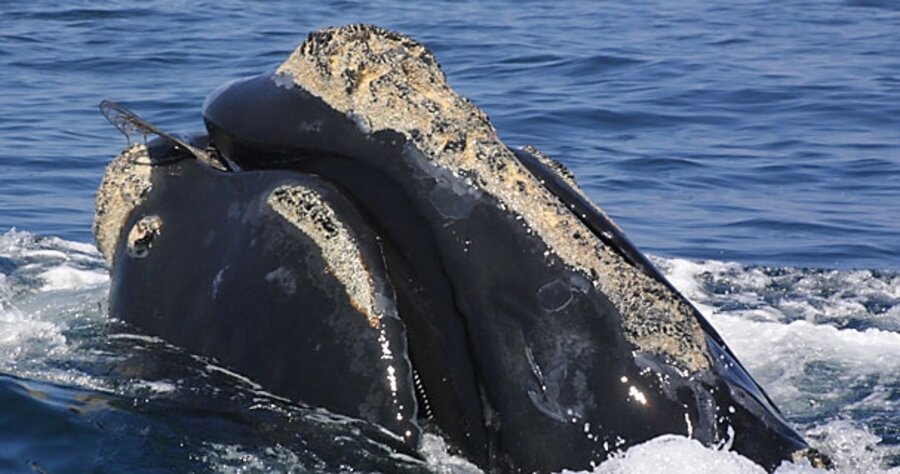Buoys help ships steer clear of right whales
Loading...
Along the Northeast coast of the United States, right whales are migrating south from their summer feeding grounds in the Bay of Fundy and Nova Scotia to Georgia and Florida. There, they’ll give birth and feed with their young through the winter.
The event draws the interest of whale watchers and researchers. But this year, researchers were delighted to discover something new: right whales swimming near New York City. Right whales have probably passed close to the city before. This time, researchers heard them.
Right whale calls were intercepted by buoys equipped with hard drives to record the sounds. The 10 buoys – three off New York Harbor and seven south of Fire Island – were deployed by Cornell University’s Lab of Ornithology in Ithaca, N.Y. The buoys recorded ocean noise for 75 days. When the buoys off Fire Island were pulled up and the recordings downloaded in May, analysts heard right whale calls.
Listening to sounds of the deep is a daily task at the Cornell lab. Analysts must sift the right whale calls from other noise. Using a different array of buoys, auto-detection ones that can pick out and record right whale calls within a radius of five nautical miles, researchers hope to prevent ship collisions with the endangered whales.
Right whales feed on zooplankton near the surface and tend to hug the coastline, so they face the dual threats of crowded shipping lanes and entanglement with fishing gear. Hunted nearly to extinction in the 1800s, the right whale was so named because it swam slowly and did not sink when killed. Although right whale hunting began to cease in 1935, the population still hasn’t recovered. Today there are about 350 to 400 North Atlantic right whales.
“In some years, we’ve lost as many right whales as are born,” says Moira Brown, senior scientist and right whale researcher at the New England Aquarium. Ship strikes and entanglement are “a huge threat for the population, and it’s really just hanging in the balance.”
Federal law now requires ships 65 feet or longer to slow to 10 knots within 20 nautical miles of ports on the East Coast. Right whales can evade ships traveling that slowly. To further prevent ship strikes,
Cornell and the Woods Hole (Mass.) Oceanographic Institute installed 16 auto-detection buoys in the Stellwagen Bank National Marine Sanctuary, a 638-square-nautical mile area off the Massachusetts coast. It is crisscrossed with shipping lanes. An offshore liquefied natural gas (LNG) terminal is there.
Analysts at Cornell monitor the buoys for right whale calls 24 hours a day when ships traveling to the LNG terminal pass through Massachusetts Bay. They listen for calls and send updates to ships in the area every 12 hours. The hydrophone-equipped autodetection buoys listen for the low frequencies (between 50 and 350 hertz) of right whale calls. When calls are detected, Cornell notifies ship captains in the area. By law, the ships must slow to less than 10 knots and post a lookout. Speed and lookout must be maintained for 24 hours when ships are traveling near a buoy where a right whale has been heard.
It’s too early to gauge the effectiveness of the buoys to prevent whale injuries. They were installed only last January. But Christopher Clark, director of Cornell’s Bioacoustics Research Program, can point to other benefits, notably more knowledge of right whale behavior.
Aerial surveys can’t spot all the whales, and bad weather can ground the flights. But with the buoys, the “chances of detecting by listening are four to six times greater than looking,” Dr. Clark says. They can listen for and track whales under any conditions, any time the whales are calling. “If they don’t call, I can’t detect it,” he adds. Noise pollution from ships and other human activities is another complicating factor.
Clark imagines building a nationwide auto-detection buoy network – one that could reach all ship captains on both coasts and protect a variety of marine mammals. He has tested buoys off Brunswick, Ga., and has installed two in Jacksonville, Fla. He plans to test three auto-detection buoys in Cape Cod Bay this winter.


